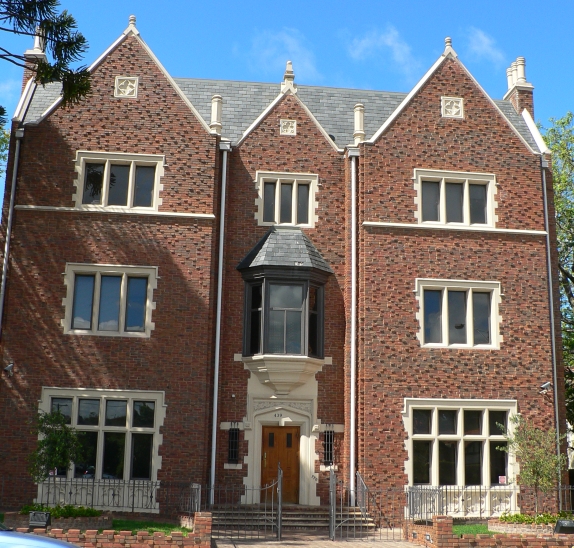- St Kilda East, Victoria
Infobox Australian Place | type = suburb
name = St Kilda East
city = Melbourne
state = vic

caption = "770" Synagogue, Inkerman Street
lga = City of Port Phillip
lga2 = City of Glen Eira
area = 2.3
postcode = 3183
pop = 12,188 (2006)Census 2006 AUS | id = SSC21639 | name = St Kilda East (State Suburb) | accessdate = 2007-09-26 | quick = on]
est = 1850s
propval = $641,500 [ [http://www.domain.com.au/public/suburbprofile.aspx?suburb=St%Kilda%East&postcode=3183 St Kilda East] , accessed17 August 2007 ]
stategov = Prahran, Caulfield
fedgov = Melbourne Ports
near-nw = Windsor
near-n = Prahran
near-ne = Armadale
near-w = St Kilda
near-e = Caulfield North
near-sw = Elwood
near-s = Balaclava,Elsternwick
near-se = Caulfield South
dist1 = 8
location1 = MelbourneSt Kilda East is an
inner city suburb ofMelbourne , Victoria,Australia . Parts of the suburb are located in both theCity of Port Phillip andCity of Glen Eira . At the 2006 Census, St Kilda had a population of 12,188.East St Kilda is one of the more diverse and densely settled neighbourhoods of Melbourne. It has a prominent
Hasidic Jewish community descended from Polish andRussia nimmigrant s.Quiet and residential, East St Kilda is quite a different neighbourhood from the spectacle of its adjacent neighbourhood, St Kilda.
History
The East St Kilda area was first settled in the 1850s.
Smaller timber shacks were common during the early 1860s to 1870s with larger houses on the bigger subdivisions.
During the late 1870s, terraced housing began around the railway line.
Alma Park was laid out and areas surrounding the park were set aside for religious purposes, resulting in a large number of convents and chapels along Chapel Street and either side of Dandenong Road.
In the 1950s, speculative development resulted in the destruction of many of the suburb's streetscapes. Centred around Chapel Street and to the east of the railway line, "dog box" flats are now common in the area.
Recent development of the suburbs, rising land values and excellent access to public transport has seen recent
gentrification in the area. Modern infill medium density apartments are being built on many blocks with the Carlisle Street area designated an activity centre under theMelbourne 2030 planning scheme.Education
The main schools in East St Kilda are the
Christian Brothers College, St. Kilda , Caulfield Campus ofCaulfield Grammar School , Malvern Community School, Ripponlea Primary School and the St Kilda East campus ofMount Scopus Memorial College , Yeshivah College, Beth Rivkah Ladies College, and part ofSt Michael's Grammar School .Culture
East St Kilda is home to the Red Stitch Actors Theatre, a professional theatre located on the corners of Dandenong Road and Chapel Street.
Transport
East St Kilda is served by several forms of public transport.
Major
tram routes operate on Carlisle/Balaclava Road,Chapel Street , Dandenong Road andSt Kilda Road .Buses operate along Orrong Road and Hotham Street.
Balaclava and Ripponlea Train Stations on the Sandringham line service the suburb too
Local Landmarks
Residential architecture
Architecturally, East St Kilda has been described as having not much of anything interesting. It is dominated by 1960s flats. There are, however, some pockets of preserved heritage streetscapes. Godfrey Avenue has well preserved rows of Edwardian cottages on either side of the street and is protected by council heritage controls. Camden Street has several rows of Victorian semi-detached timber terraces.Some large Victorian buildings remain along Inkerman and Alma Roads, but have been since subdivided into flats. In the streets in between is a mix of housing from different periods.
Non-residential architecture
Places of worship
There are many churches in St Kilda East; many of the modern places of worship serve the Jewish Faith, but many of the older buildings have at some point served various
Christian religions.Many of the church buildings in St Kilda East are historic and heritage registered and form various religious precincts.The St Mary's Catholic Church (208-214 Dandenong Road) was designed byWilliam Wardell was one of the earliest bluestone churches and was built in 1858. The bluestone All Saints Anglican Church on Chapel Street was built in 1861. The neighbouring Parish Hall was built as an extension to the church in 1909 and was restored in 2005 during a conversion into a boutiquegym nasium. The East St Kilda Uniting Church on the corner of Hotham and Inkerman streets was built in 1887 to the design of Hillson Beasley architect. The St George's Presybterian Church, Chapel Street was built in 1877. It has been leased bySt Michael's Grammar School since 1990. St George's Presbyterian Church also on Chapel Street was built between 1877-80 to the design of Albert Purchas and is listed on the Victorian Heritage Register. The former Balaclava Corps Hall, built in 1929 on Camden Street is an unusual design featuring castellated motifs.Public spaces
East St Kilda has a notable lack of public space. The main park is Alma Park, a large park designed by Clement Hodgkinson in 1867, which was split in two linear parks by railway lines in 1858. The park has recreational facilities including a heritage 1880s rotunda,
cricket andfootball (soccer) oval and large stands ofelm trees,Moreton Bay Fig s, bike paths and native vegetation areas.St Kilda Cemetery covers a large block bordered by Dandenong and Alma Road and Hotham and Alexandra Street. It is bounded by a historic wall and contains many Victorian era graves. The cemetery is the resting place of Alfred Deakin andAlbert Jacka , VC, MC and Barrister and mayor of St Kilda (1930).See also
*
City of Caulfield - the former local government area of which St. Kilda East was a part.
*City of St Kilda - the former local government area of which St. Kilda East was a part.References
External links
* [http://web.archive.org/web/20041015165856/www.arts.monash.edu.au/ncas/multimedia/gazetteer/list/stkildaeast.html Australian Places - St Kilda East]
* [http://web.archive.org/web/20040702081249/www.arts.monash.edu.au/ncas/multimedia/gazetteer/list/balaclava.html Australian Places - Balaclava]
Wikimedia Foundation. 2010.
